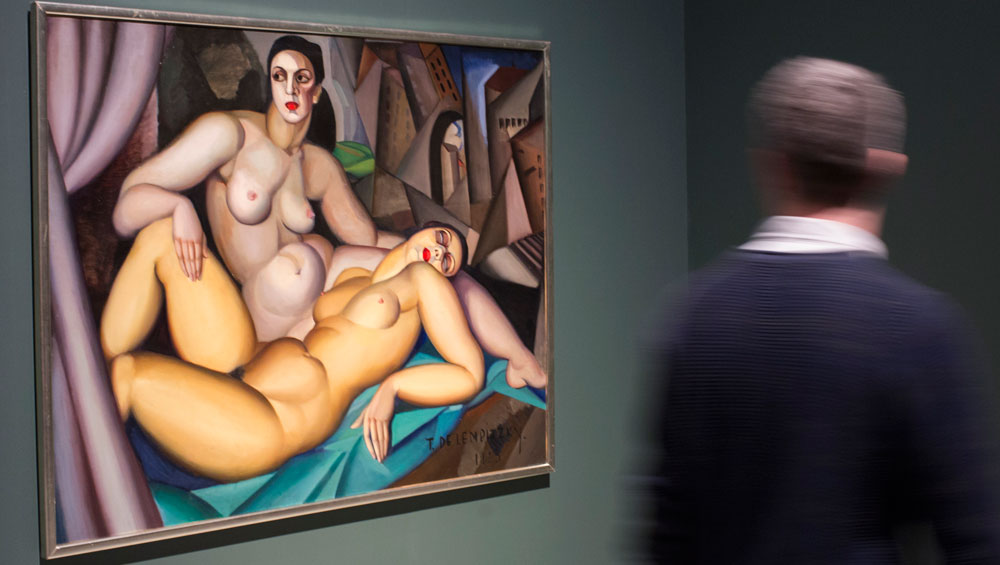
Barbican Art Gallery, London
10 October 2018 – 27 January 2019
by CELIA WHITE
Hashed and rehashed histories of the 20th-century avant garde often centre on individual geniuses, light-bulb moments, accidental discoveries and creative breakthroughs – all predominantly male and suffused with cliche. The Barbican’s Modern Couples rethinks this history by dispensing with the idea of modernism as a cast of lone rangers, and looks instead at how it emerged from coupledom: from relationships based on love, friendship, circumstance, pure desire, or shared creative interests. As part of this, contributions by women artists and queer and trans communities are presented with new prominence, with the show promising a shift away from the notion that avant-garde art and literature was the achievement of a select group of men.
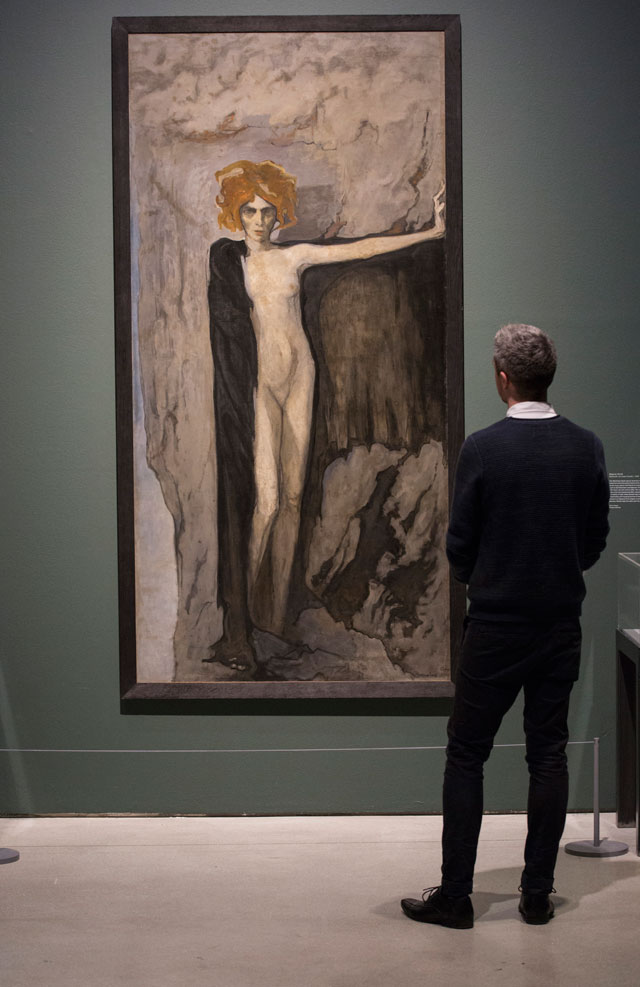
Romaine Brooks, Portrait of Luisa Casati, 1920. Installation view, Modern Couples: Art, Intimacy and the Avant-garde, Barbican Art Gallery, 10 October 2018 – 27 January 2019. © John Phillips / Getty Images.
The exhibition, however, is overstuffed: 40 couples or groups are explored across 23 rooms (plus the stairwell and two corridors), with each wall text giving a lightning-speed history of how they met, the nature of their relationship, their shared ideas and artistic activities, any extra social, political and geographical details, as well as quotations and a display of artworks, letters, gifts and photographs (many with their own discursive captions). The research is expansive and the insights given are fascinating, but it feels as if these fresh perspectives have been pared down substantially simply to fit everything in. Doing justice to each couple would mean spending a good chunk of time in each room; doing justice to the show’s argument would therefore mean spending the whole day there. The Barbican has rather naively plumped for both quantity and quality, with the curator passing on the physical and intellectual burden to the unsuspecting viewer.
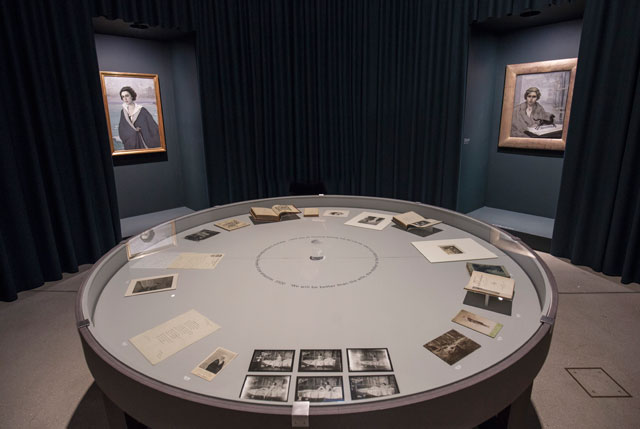
Modern Couples: Art, Intimacy and the Avant-garde. Installation view, Barbican Art Gallery, 10 October 2018 – 27 January 2019. © John Phillips / Getty Images.
Each couple’s narrative is drawn together through one key element of their artistic collaboration or mutual influence. These intersections are where the real art historical freshness lies, especially regarding women’s roles in avant-garde practice. The room featuring Dora Maar and Pablo Picasso highlights Maar’s ambivalence over Picasso’s many paintings of her (although more information on this ambivalence would have been welcome), illustrated by his pensive-looking Portrait de femme (1938). It also showcases Maar’s own photographs of Picasso, whether posing as a minotaur on the beach, or sitting for a portrait, the space around his face violently scratched away. While the wall text makes the rather basic observation that, “In a turnaround of expectations, Picasso becomes Maar’s muse”, this is a lesser-known reversal worthy of much deeper investigation.
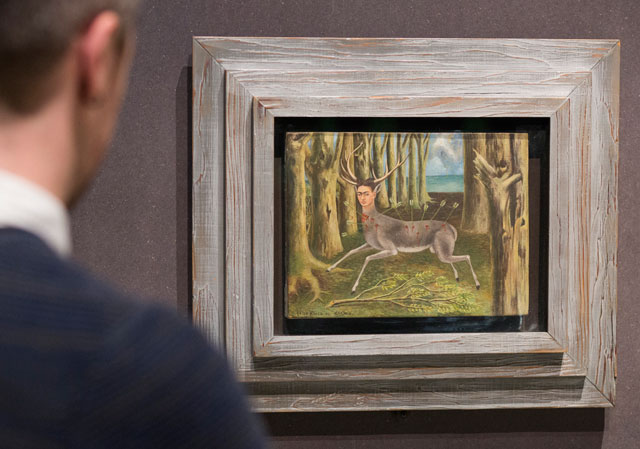
Frida Kahlo, Le Venadita (little deer), 1946. Installation view, Modern Couples: Art, Intimacy and the Avant-garde, Barbican Art Gallery, 10 October 2018 – 27 January 2019. © John Phillips / Getty Images.
More famous is Lee Miller’s pursuit of Man Ray in Paris in the late 1920s, resulting in her becoming his studio assistant, lover and collaborator in photographic experimentation. This relationship and their mutual interest in the boundaries of sexual desire and violence are aptly illustrated here through works such as Hommage à D.A.F. de Sade (1930), showing a pair of heads trapped in bell jars. This room places greater emphasis on Miller than Man Ray, stressing that it was she who eventually left him to set up her own studio and marry someone else. It also notes that works attributed to Man Ray have recently been reidentified as co-authored by the pair, although it is not clear if the photographs included in the display are these works, or simply representative examples of their joint experiments in surrealist photographic narrative, photo-collage and solarisation.
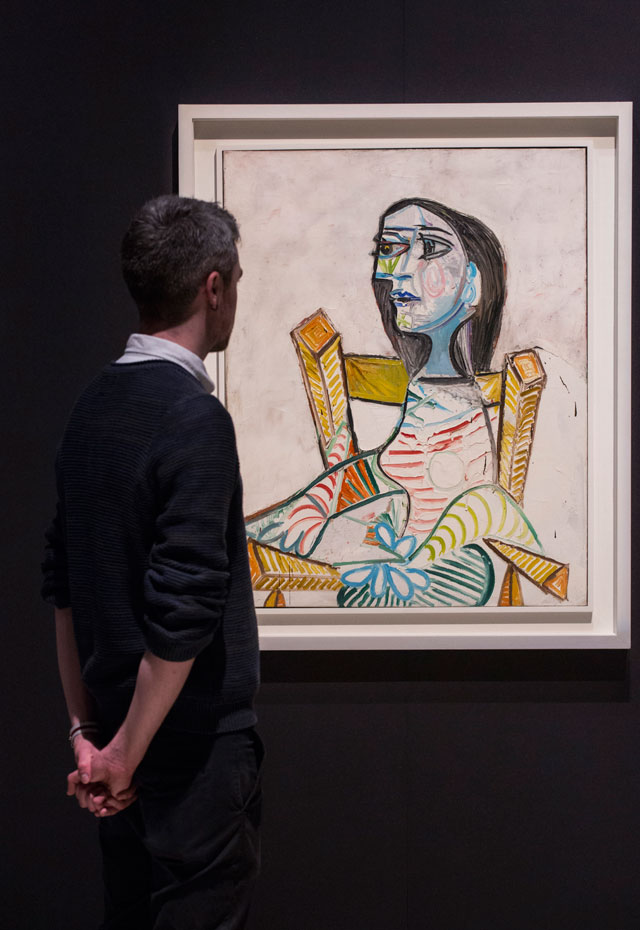
Pablo Picasso, Portrait de femme,1938. Installation view, Modern Couples: Art, Intimacy and the Avant-garde, Barbican Art Gallery, 10 October 2018 – 27 January 2019. © John Phillips / Getty Images.
This belated recognition of co-authorship appears elsewhere in the exhibition: a brief display in the stairwell reports that Ludwig Mies van der Rohe’s famous 1929 Barcelona chair was, in fact, a collaboration with fellow designer Lilly Reich. “She taught me to think,” said Mies. Such quotations highlight a slightly misjudged tone at times in Modern Couples, wherein the idea that men allowed for, or retrospectively admitted, the contributions made by women goes largely unchallenged. In the surrealist group room Mad Love, for instance, a whole host of partnerships is presented, highlighting the work of Jacqueline Lamba and Gala, among many others. But the text barely unpacks and contests André Breton’s description of women as being “innately surrealist”. Instead, it observes cavalierly: “While the position of women within surrealism was a complex one in which objectification abounded, the group’s aspirations offered women a space to daringly assert themselves.”
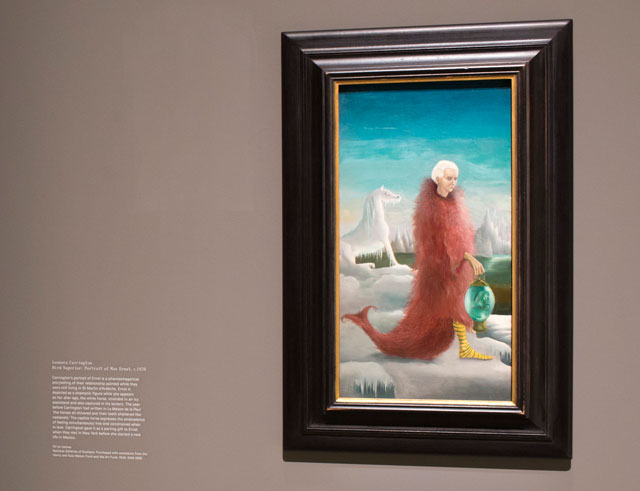
Leonora Carrington, Bird Superior: Portrait of Max Ernst, c1939. Installation view, Modern Couples: Art, Intimacy and the Avant-garde, Barbican Art Gallery, 10 October 2018 – 27 January 2019. © John Phillips / Getty Images.
The most tightly argued and enjoyable pairings appear when we stray from romance and the cult of personality towards a more sustained examination of how intimacy affected stylistic development. Federico García Lorca and Salvador Dalí’s friendship, artistic exchange and possible sexual relationship are all narrated through a discussion of their writings and their art, rather than simply lying adjacent to it, as in other rooms. Mutual influence is the mode, here, with Dalí’s painting influencing Lorca’s fluid, delicate works on paper, and Lorca’s writing inspiring an exchange consisting of poetic wordplay and visual and textual combinations. Set alongside quotations, visual works and pieces of poetry are some of the pair’s letters, crystallising their creative dialogue. A missive from Dalí to Lorca from 1926, for example, features a found image of varicose veins paired with a soft-focus photograph of a woman’s head and bare shoulder, reflecting Dalí and Lorca’s appreciation of sinister witticisms based on combining beauty and ugliness.
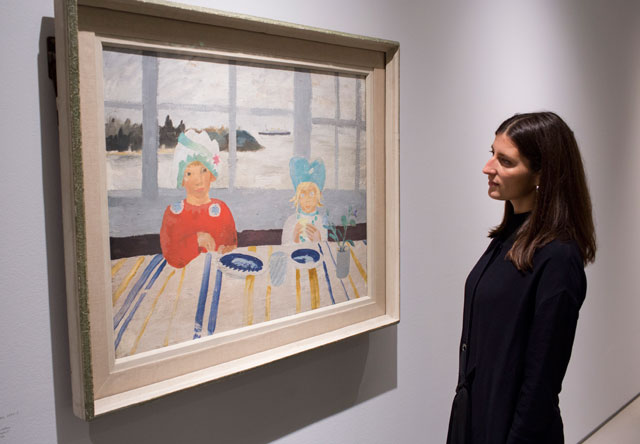
Winifred Nicholson, Jake and Kate on the Isle of Wight, 1931. Installation view, Modern Couples: Art, Intimacy and the Avant-garde, Barbican Art Gallery, 10 October 2018 – 27 January 2019. © John Phillips / Getty Images.
Where several relationships appear in one room, these are often carefully linked to show how one artist’s work has benefited from several collaborations. As lovers, Hannah Höch and Raoul Hausmann pushed the boundaries of dada collage while exploring sexual liberation (Hausmann was married) and attempting to overturn patriarchy in society through Hausmann’s successful campaign to have Höch included in the First International Dada Fair. From a selection of their photo-collages we move on to the story of Höch’s subsequent same-sex relationship with writer Til Brugman, involving mutual encouragement that led to each other’s debuts: Brugman arranged Hoch’s first solo exhibition in The Hague in 1929, while Höch illustrated Brugman’s 1935 writings, Scheingehacktes, a copy of which is displayed here.
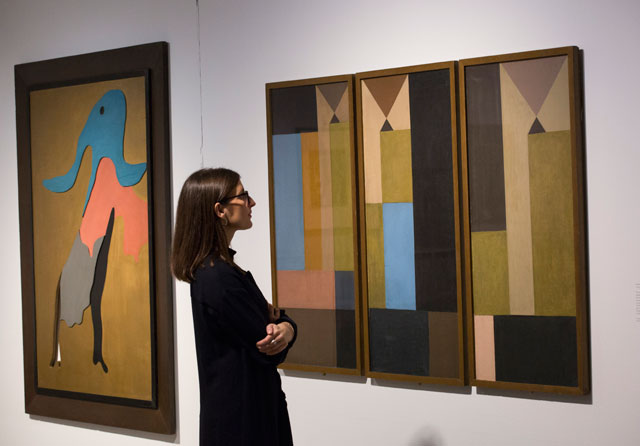
Jean Arp, Tänzerin (Danseuse), 1925 and Sophie Taeuber-Arp, Triptyque, 1918. Installation view, Modern Couples: Art, Intimacy and the Avant-garde, Barbican Art Gallery, 10 October 2018 – 27 January 2019. © John Phillips / Getty Images.
Likewise, Winifred and Ben Nicholson’s painterly experiments with flatness and the depiction of family life bleed into Ben Nicholson’s departure for a relationship with Barbara Hepworth, here emphasising the shifts in style and formthat their coming together precipitated for both parties. This merges into the section on Jean Arp and Sophie Taeuber-Arp, friends of Nicholson and Hepworth who shared their experimental approach to abstraction – a coupling of couples shown visually in a white relief by Nicholson, Hepworth’s sculpture Tides 1 (1946) and Jean Arp’s painting Dancer (1923).
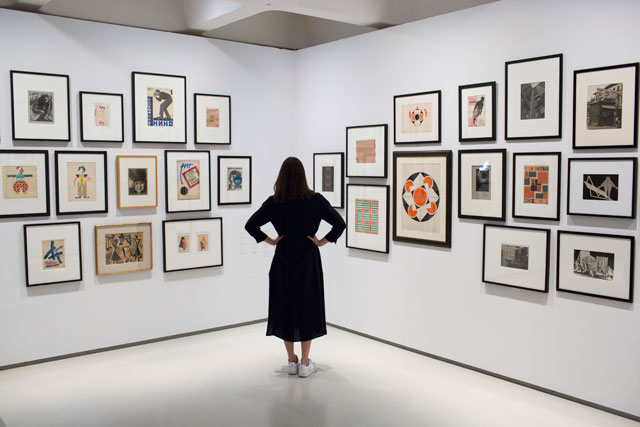
Modern Couples: Art, Intimacy and the Avant-garde. Installation view, Barbican Art Gallery, 10 October 2018 – 27 January 2019. © John Phillips / Getty Images.
Unity is a recurring refrain in Modern Couples – Diego Rivera and Frida Kahlo are cast as creative equals, independent yet devoted to one another in their unlikely “union of an elephant and a dove”, a romantic mythology echoed in Leonora Carrington and Max Ernst’s personal symbolism of the Bird Superior and the Bride of the Wind. Russian avant-garde leaders Natalia Goncharova and Mikhail Larionov collectively developed rayism, a form of abstraction influenced by futurism and current scientific developments. Stating “We have joined art to life”, they also demonstrated their creative unity by painting their faces, merging with a new modernist reality and, necessarily, with each other: “We paint ourselves because a clean face is offensive … we want to herald the unknown, to rearrange life and to bear man’s multiple soul to the upper realms of reality.” Likewise, futurist Filippo Tommaso Marinetti and his wife Benedetta co-developed tactilism in the early 1920s, represented in the show by the co-authored work Sudan-Paris 1920. The influence of Benedetta seemingly led to an about-face for Marinetti, who had previously called for a “disrespect for women” and their inherent sentimentalism.
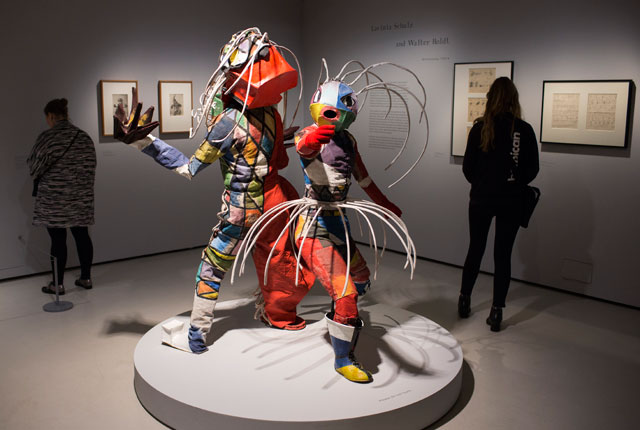
Minya Diez-Dührkoop, Tanzmaske ‘Toboggan Frau’ and ‘Toboggan Mann’ by Lavinia Schulz, 1924. Installation view, Modern Couples: Art, Intimacy and the Avant-garde, Barbican Art Gallery, 10 October 2018 – 27 January 2019. © John Phillips / Getty Images.
Modern Couples might be more digestible if it were less heavy on biographical detail, instead using a themed approach led by these creatives’ ideas and artworks. Looking at the exhibition leaflet provided to visitors on entry, it seems there is, in fact, an alternative way to move around the show – albeit unofficial. The leaflet features a glossary of concepts that recur in the exhibition (Love, Desire, Revolution, Non-Binary, Utopia), many concluding with a list of rooms where these ideas can be found: see rooms two, three, 12 and 22 for lovers’ gifts, for instance; rooms eight and nine for homoeroticism; six, nine and 11 for selfies; and four, nine and 16 for “publishing”. (In fact, a couple of the rooms are already themed, suggesting curatorial to-ing and fro-ing over whether to take this approach for the whole hang.) Taking this other tack, and disrupting the prescribed viewing experience, the show ceases to be a staccato succession of personal stories of meeting, colliding and parting. It frees the exhibition from the obsession with avant-garde individualism that it was designed to redress, but nevertheless perpetuates.